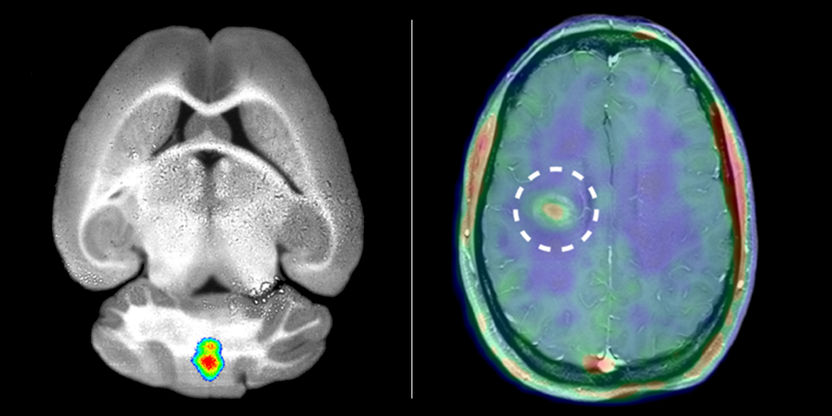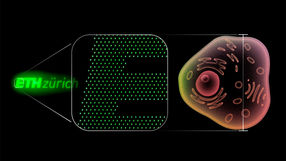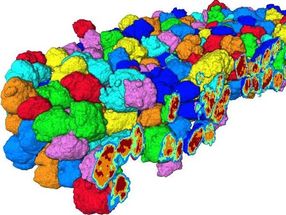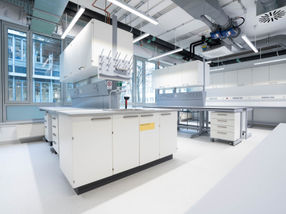Ongoing inflammation in the human brain made visible
For the first time, Researchers at the Cells-in-Motion Cluster of Excellence (CiM) at Münster University have been able to image ongoing inflammation in the brain of patients suffering from multiple sclerosis.

Researchers at the Cells-in-Motion Cluster of Excellence have visualized inflammation in the brain of mice (l.) and of MS patients (r.). To do so, they labelled specific enzymes (MMPs).
© Nachdruck mit Genehmigung des Verlags aus:/Reprinted with permission from: Gerwien und Hermann et al., Sci. Transl. Med. 8, 364ra152 (2016) 9. November 2016
The ultimate aim in biomedical research is the transfer of results from experiments carried out in animals to patients. Researchers at the Cells-in-Motion Cluster of Excellence (CiM) at the University of Münster have succeeded in doing so. For the first time, they have been able to image ongoing inflammation in the brain of patients suffering from multiple sclerosis (MS). This involved specialists from different disciplines working together in a unique way over several years, combining immunology, neurology and imaging technologies ranging from microscopy to whole-body imaging.
The consequences of an inflammation in the brain can already be shown using a clinically established process: magnetic resonance imaging (MRI). Making the inflammation itself visible too could, in future, help not only to more accurately diagnose multiple sclerosis patients but also to monitor therapies and apply them in a more specific way.
Occurring mostly in sporadic attacks, the flares associated with multiple sclerosis cause patients considerable discomfort. In this autoimmune disease, immune cells – in other words, cells from the body's own defence system – target the very organism they are supposed to protect. To do so, they must first penetrate the so-called blood-brain barrier to then be able to attack the central nervous system.
For the first time, CiM researchers have used certain enzymes – matrix metalloproteinases (MMPs) – to image inflammation in the brain that typically occurs during flares in MS patients. In a preliminary study, biologists and biochemists in a team headed by CiM Spokesperson Prof. Lydia Sorokin discovered that these enzymes play a pivotal role. They had investigated mice with a similar disease to MS and found that MMPs are essential for immune cell penetration of the blood-brain barrier and their migration into the brain, where they cause inflammation.
In order to label these enzymes in the brain and visualize them through specialized imaging techniques, a team of chemists and nuclear medicine specialists headed by one of CiM Coordinators, Prof. Michael Schäfers, developed a tracer – a chemical substance that tracks down the active enzymes in the body and binds to them. The chemists linked the MMP tracer with a fluorescent dye. The fluorescence light signals from such a tracer can be measured using optical imaging techniques. Via the tracer signal the researchers were able to localize and measure the activity of the enzymes, initially in mice. "We found that our observations of MMP activity provided precise information on where immune cells penetrate the blood-brain barrier and where inflammation occurs in the brain," says Dr. Hanna Gerwien, a molecular biologist.
First case studies with patients
The researchers have now succeeded in transferring the method to humans. However, it was not possible to use the fluorescent tracer because its light signal would not penetrate the skull of a patient. The researchers therefore modified the tracer, adding a radioactive signal transmitter instead of a fluorescent dye. The radiation it emits can be measured and made visible using a special method, positron emission tomography (PET). Nuclear medicine specialists and neurologists at the Cluster of Excellence in Münster (who also work at Münster University Hospital) have now carried out the first case studies on MS patients. The result was that in patients with acute attacks of MS the tracer accumulated clearly in defined areas, even before any damage to the blood-brain barrier could be measured using the traditional method, magnetic resonance imaging.
"It really was something special to be able to corroborate something in a patient that had already discovered in basic research in experiments on animals," says Dr. Sven Hermann, an expert in nuclear medicine and small animal imaging, "it's what every scientist dreams of". The scientists also observed, as they predicted, that little or no tracer accumulated after the patients had undergone anti-inflammatory therapy.
The investigation described here is a pilot study. This process has not been used in clinical practice.
Original publication
Gerwien H, Hermann S, Zhang X, Korpos E, Song J, Kopka K, Faust A, Wenning C, Gross CC, Honold L, Melzer N, Opdenakker G, Wiendl H, Schäfers M, Sorokin L.; "Imaging Matrix Metalloproteinase Activity in Multiple Sclerosis as a Specific Marker of Leukocyte Penetration of the Blood-Brain Barrier"; Science Translational Medicine; 2016





















































